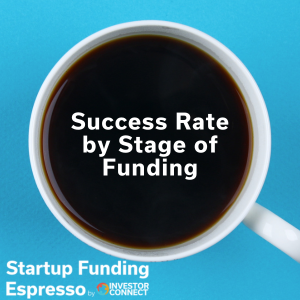

Success Rate by Stage of Funding
The success rate of startups declines as one moves from seed to Series A and so forth.
Success is defined as a successful exit for the investors through an acquisition of the company.
Here’s the rate of success of startups at each stage of funding.
Seed — 9%
Series A– 12%
Series B — 14%
Series C — 15%
Series D — 16%
Many startups stop raising funding and turn into a steady state business before reaching an acquisition exit.
Here’s the rate at which companies go on to raise at the next stage of funding:
Series A — 40%
Series B — 25%
Series C — 15%
Series D — 5%
This shows the percent of startups still raising funding after each round.
Thank you for joining us for the Startup Funding Espresso where we help startups and investors connect for funding.
Let’s go startup something today.
Thank you for joining your host Hall T. Martin with the Startup Funding Espresso — your daily shot of startup funding and investing.
For more episodes from Investor Connect, please visit the site at: http://investorconnect.org
Check out our other podcasts here: https://investorconnect.org/
For Investors check out: https://tencapital.group/investor-landing/
For Startups check out: https://tencapital.group/company-landing/
For eGuides check out: https://tencapital.group/education/
For upcoming Events, check out https://tencapital.group/events/
For Feedback please contact info@tencapital.group
Please follow, share, and leave a review.
Music courtesy of Bensound.
Copyright (c) 2024, Hall Martin and investorconnect.org. All rights reserved.
Disclaimer:
Hall T Martin is the director of Investor Connect, which is a 501(c)(3) nonprofit dedicated to the education of investors for early-stage funding. All opinions expressed by Hall and podcast guests are solely their own opinions and do not reflect the opinion of Investor Connect. This podcast is for informational purposes only and should not be relied upon for the basis of investment decisions.











